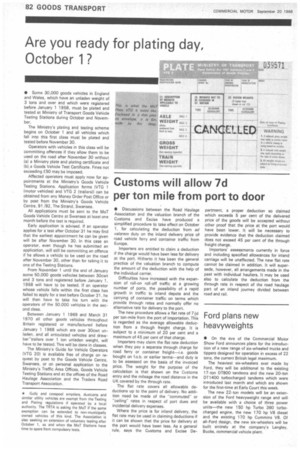Customs will allow 7d per ton mile from port to door
Page 86

If you've noticed an error in this article please click here to report it so we can fix it.
• Discussions between the Road Haulage Association and the valuation branch of the Customs and Excise have produced a simplified procedure to take effect on October 1, for calculating the deduction from ad valorem duty on the inland delivery price ofroad vehicle ferry and container traffic from Europe.
Importers are entitled to claim a deduction if the charge would have been less for delivery at the port. Hitherto it has been the general practice of the valuation branch to compute the amount of the deduction with the help of the individual carrier.
Difficulties have increased with the expansion of roll-on roll-off traffic at a growing number of ports, the possibility of a rapid growth in traffic to inland depots and the carrying of container traffic on terms which provide through rates and normally offer no alternative rate for delivery to the port.
The new procedure allows a flat rate of 7-1-d per ton-mile from the port of importation. This is regarded as the average allowable deduction from a through freight charge. It is subiect to a minimum of 20 per cent and a maximum of 45 per cent of that charge.
Importers may claim the flat rate deduction when they pay a separate through charge for road ferry or container freight—i.e. goods bought on f.o.b. or earlier terms—and duty is to be assessed on the basis of the invoiced price. The weight for the purpose of the calculation is that shown on the Customs entry and the mileage the road distance in the UK covered by the through rate.
The flat rate covers all allowable deductions up to the point of delivery. No addition need be made of the "commuted" or "ceiling" rates in respect of port dues and incidental delivery expenses.
Where the price is for inland delivery, the flat rate may be used in claiming deductions if it can be shown that the price for delivery at the port would have been less. As a general rule, says the Customs and Excise De
partment, a proper deduction so claimed which exceeds 5 per cent of the delivered price of the goods will be accepted without other proof that the price at the port would have been lower. It will be necessary to provide evidence that the deduction claimed does not exceed 45 per cent of the through freight charge.
Importers' assessments currently in force and including specified allowances for inland carriage will be unaffected. The new flat rate cannot be claimed in addition. It will supersede, however, all arrangements made in the past with individual hauliers. It may be used also to calculate the deduction from the through rate in respect of the road haulage part of an inland journey divided between road and rail.


















































































































































































































































































































































































